Osaka Castle
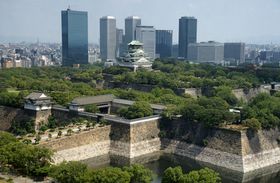
Osaka Castle (大坂城・大阪城 Ōsaka-jō) is a Japanese castle in Chūō-ku, Osaka, Osaka Prefecture, Japan.
Originally called Ozakajō, it is one of Japan's most famous castles, and played a major role in the unification of Japan during the sixteenth century of the Azuchi-Momoyama period. Osaka Castle is situated on a plot of land roughly one kilometer square. It is built on two raised platforms of landfill supported by sheer walls of cut rock, using a technique called Burdock piling, each overlooking a moat. The central castle building is five stories on the outside and eight stories on the inside, and built atop a tall stone foundation to protect its occupants from sword-bearing attackers.
The Castle grounds, which cover approximately 60,000 square meters (15 acres)[1] contain thirteen structures which have been designated as Important Cultural Assets by the Japanese government,[2] including the Toyokuni Shrine, dedicated to Toyotomi Hideyoshi.
The castle is open to the public, and is easily accessible from Osakajōkōen Station on the JR West Osaka Loop Line. It is a popular spot during festival seasons, and especially during the cherry blossom bloom (hanami), when the sprawling castle grounds are covered with food vendors and taiko drummers. The large indoor arena Osaka-jo Hall is also located within the grounds of the castle park.
Contents |
History

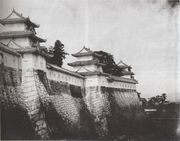
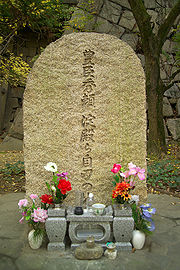
- 1583: Toyotomi Hideyoshi commenced construction on the site of the Ikkō-ikki temple of Ishiyama Hongan-ji. The basic plan was modeled after Azuchi Castle, the headquarters of Oda Nobunaga. Toyotomi wanted to build a castle that mirrored Oda's, but surpassed it in every way: the plan featured a five-story main tower, with three extra stories underground, and gold leaf on the sides of the tower to impress visitors.
- 1585: Inner donjon completed. Toyotomi continued to extend and expand the castle, making it more and more formidable to attackers.
- 1597: Construction completed but Hideyoshi died. Osaka Castle passed to his son, Toyotomi Hideyori.
- 1600: Tokugawa Ieyasu defeated his opposers at the Battle of Sekigahara, and started his own bakufu in Edo.
- 1614: Tokugawa attacked Hideyori in the winter, starting the Siege of Osaka[3]. Although the Toyotomi forces were outnumbered approximately 2 to 1, they managed to fight off Tokugawa's 200,000-man army and protect the castle's outer walls. However, Tokugawa attempted to muzzle Toyotomi by filling up the castle's outer moat, rendering it largely defenseless.
- 1615: During the summer, Hideyori began to dig the outer moat once more. Tokugawa, in outrage, sent his armies to Osaka Castle again, and routed the Toyotomi men inside the outer walls on June 4. Osakajo fell to Tokugawa, and the Toyotomi clan perished.
- 1620: The new heir to the shogunate, Tokugawa Hidetada, began to reconstruct and rearm Osaka Castle. He built a new elevated main tower, five stories on the outside and eight stories on the inside, and assigned the task of constructing new walls to individual samurai clans. The walls built in the 1620s still stand today, and are made out of interlocked granite boulders with no mortar whatsoever; they are held together solely by each other. Many of the stones were brought from rock quarries in the Seto Inland Sea, and bear inscribed crests of the various families who laid them into the walls.
- 1660: Lightning exploded the gunpowder warehouse. And, the castle surrounding set on fire.
- 1665: Lightning strikes burned down the main tower.
- 1843: After decades of neglect, the castle got much-needed repairs when the bakufu collected money from the people of the region to rebuild several of the turrets.
- 1868: Fall of Osaka castle. Much of the castle was burned in the civil conflicts surrounding the Meiji Restoration. Under the Meiji government, Osaka Castle was converted to a barracks for Japan's rapidly-expanding Western-style military.
- 1928: The main tower was restored after the mayor of Osaka concluded a highly successful fund-raising drive.
- 1945: Bombing raids on Osaka damaged the reconstructed main tower.
- 1995: Osaka's government approved yet another restoration project, with the intent of restoring the main tower to its Edo-era splendor.
- 1997: Restoration was completed. The castle is a concrete reproduction (including elevators) of the original, although the interior does not resemble a Japanese castle at all.
See also
- List of Special Places of Scenic Beauty, Special Historic Sites and Special Natural Monuments
- Edo Castle
- Himeji Castle
References
- ↑ "Osaka / Osaka Castle". Japanese National Tourist Organization. http://www.jnto.go.jp/eng/location/regional/osaka/osakajo.html. Retrieved 2008-01-22.
- ↑ "Osaka Castle: Osaka Visitor's Guide". Osaka Tourist Guide. http://www.tourism.city.osaka.jp/en/search/detail/sightseeing_1933.html. Retrieved 2008-01-22.
- ↑ Meek, Miki. "The Siege of Osaka Castle". National Geographic Magazine. http://ngm.nationalgeographic.com/ngm/0312/feature5/zoomify/main.html. Retrieved 2008-01-22.
Gallery: Castle in perspective
Panorama overview
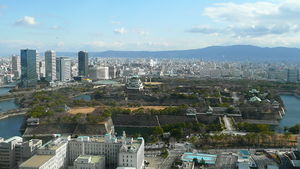
Central tower
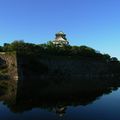 Tower reflected in surface of moat. |
 |
 |
Moat and outer walls
 Ruins of the walls, with the rebuilt tenshu rising up in the center-right. |
 Otemon (western) Gate. |
Non-photographic images
 Early representation of the destruction of Osaka Castle in François Caron's 1663 book. |
Literature
- Schmorleitz, Morton S. (1974). Castles in Japan. Tokyo: Charles E. Tuttle Co.. pp. 69–78. ISBN 0-8084-1102-4.
- Motoo, Hinago (1986). Japanese Castles. Tokyo: Kodansha. pp. 200 pages. ISBN 0-87011-766-1.
External links
 Media related to Osaka Castle at Wikimedia Commons
Media related to Osaka Castle at Wikimedia Commons- WikiTravel:Osaka
- Official web site
- Satellite image with structures in complex labelled
- Japanese Castle Explorer - Osaka Castle
- NASDA satellite image of castle and surrounds (Japanese)
- GoogleMaps satellite image
- Photograph of castle and surrounding city